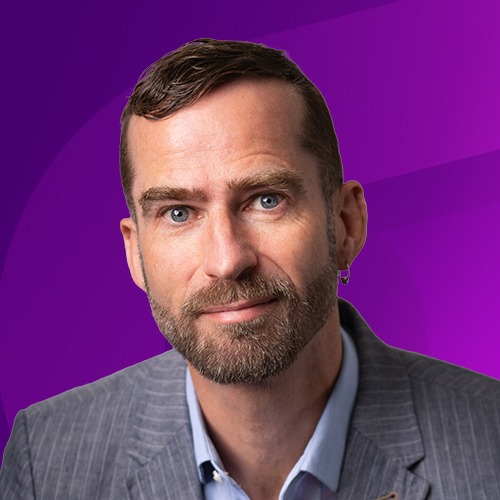In this edition of Gamechangers in Resilience, we sit down with Mark Heywood, a seasoned crisis management expert, writer, and presenter, whose career uniquely spans corporate resilience leadership, risk, and storytelling.
With 20 years in crisis response, advising multinational organizations on terrorism, cyber threats, and natural disasters, and a parallel career in film, television, and publishing, Mark brings a fresh perspective on leadership under pressure. His ability to translate complex risks into compelling narratives makes him a sought-after consultant, host, and thought leader.
In Part 1 of this conversation, Mark shares key insights on board-level crisis leadership, decision-making pitfalls, and the role of creativity in resilience—offering practical takeaways for executives and risk professionals navigating an increasingly volatile world.
Q: You have a fascinating background that blends both right and left-brain thinking – traversing unusual combinations of fields such as risk, crisis management, acting, and writing. Can you take us through what that journey has been like for you?
Mark: The journey has been nothing short of fascinating, and I often think of it as a dance between structure and creativity – two forces that many see as opposites, but for me, have always been deeply interconnected. My career has been about finding the balance between these two worlds, and in that, I’ve discovered some of my greatest insights.
I started in the corporate world – a highly structured, analytical environment where my focus was on risk and crisis management. It was about creating systems, understanding probabilities, managing uncertainty, and, most importantly, solving problems under pressure. These experiences taught me discipline, decision-making, and how to remain calm when the stakes were high. They shaped my ability to see patterns, connect dots, and build frameworks for navigating chaos.
But what was brewing underneath all of that was an equally powerful force: creativity. Even in the midst of corporate life, I was drawn to storytelling, writing, and later, presenting and performing. What began as a personal interest grew into a parallel pursuit. Storytelling, for instance, is the ultimate lesson in human behaviour. It taught me empathy – not just in the emotional sense, but the ability to truly step into someone else’s shoes, see their motivations, and communicate in ways that resonate. That understanding fed directly back into my work, helping me connect with people in more meaningful ways, especially in high-pressure situations.
Writing, like risk management, is about structure. You start with a blank page, but to build something that flows, you need to organise your ideas and take the audience on a journey. It’s not as different from solving a corporate crisis as one might think.
In hindsight, what I’ve learned is that these seemingly contrasting fields complement each other beautifully. The corporate world taught me precision, strategy, and problem-solving. The creative world gave me adaptability, empathy, and the ability to think laterally. When I brought those two mindsets together, I found myself not just solving problems but reimagining them. I wasn’t just mitigating risks; I was seeing opportunities in them. I wasn’t just managing crises; I was telling stories that motivated people to overcome them.
Ultimately, this journey has been about curiosity – a refusal to be boxed into one identity, one way of thinking, or one set of rules. I’ve found that the most unexpected pairings in life are often the most rewarding.
Today, when I work with people or businesses, I draw on both sides of my experience. It’s not about left brain or right brain – it’s about whole brain thinking. And it’s that blend that helps me offer a perspective that is unconventional, yet practical.
Life, after all, isn’t linear – so why should we be?
Q: You interface frequently with boards and executive teams. How do the most impactful boards drive effective response in a crisis?
Mark: The most impactful boards understand that their role in a crisis is not to manage the crisis directly but to guide the organisation through it by providing clarity, focus, and support. That distinction is critical. Boards that try to micromanage or step into operational territory during a crisis often end up muddying the waters, slowing decision-making, and, in the worst cases, exacerbating the problem. The most effective boards act as stabilising forces, ensuring the organisation’s leadership has what it needs to respond swiftly and decisively.
From my experience working with boards and executive teams, there are five key behaviours that set the most impactful boards apart in a crisis:
1. Clarity of roles and responsibilities
In a crisis, there is no room for ambiguity. The best boards understand their boundaries and the importance of empowering the CEO and executive team to take the lead operationally. Their role is to focus on governance, strategy, and oversight.
2. Steadying the leadership team
Crises are as much about psychology as they are about action. Boards that have the greatest impact prioritise the emotional resilience of the leadership team. They bring a sense of calm, projecting stability even when the situation is dire.
3. Demanding focus on the big picture
When you’re in the thick of a crisis, the temptation is to get caught up in the day-to-day chaos. Strong boards keep the executive team focused on what matters most – protecting the organisation’s long-term viability, reputation, and values.
4. Ensuring speed and decisiveness
Time is everything in a crisis, and the best boards understand the value of swift, informed decisions. They don’t bog down the executive team with unnecessary approvals or bureaucratic bottlenecks. Instead, they streamline decision-making and empower committees to act quickly as events unfold.
5. Communicating consistently
Effective boards recognise their responsibility in maintaining trust – both internally with employees and externally with stakeholders. They ensure clear, consistent messaging that reinforces the organisation’s commitment to managing the crisis effectively.
The common thread? Resilience and trust.
Ultimately, the boards that drive the most effective responses in a crisis are those that have built a foundation of resilience and trust well before the crisis hits. They understand the organisation deeply, have established a strong relationship with the CEO and executive team, and have the self-awareness to recognise their own limitations. This allows them to focus on what truly matters – guiding the organisation through the storm and setting it up to emerge stronger on the other side.
If I had to sum it up in one phrase, it’s this: Impactful boards don’t try to solve the crisis themselves – they create the conditions that enable the organisation to solve it.
And that’s what leadership at the board level is all about.
Q: Boards in crisis situations: what are some of the frustrations and learnings that surfaced over the years?
Mark: Boards in crisis situations can be fascinating and, at times, frustrating arenas. They are where power dynamics, egos, and governance structures meet the real-world test of urgency and uncertainty. Over the years, I’ve observed certain patterns of behaviour – both frustrations that derail progress and lessons that, when applied, transform the board from a potential liability into a true asset during a crisis.
Frustrations:
-
Too much debate, too little action
- In high-pressure situations, boards can become overly focused on discussing the problem instead of enabling the solution. Members debate endlessly over data, details, or hypotheticals, slowing the decision-making process when speed is critical.
- Boards often include highly analytical individuals who want to ensure decisions are airtight. But in crises, perfection is a luxury. Over-analysis stems from fear of making a wrong move.
-
Micromanaging the executive team
- Some boards attempt to step into the operational trenches, directing the day-to-day crisis response. This undermines the executive team, creates confusion, and disrupts the chain of command.
- Board members often feel a personal sense of accountability in a crisis. If trust in the executive team isn’t strong, their instinct is to step in and fix it rather than enabling leadership to act.
-
Conflict amongst board members
- Crises have a way of surfacing dormant tensions. Board members with differing agendas, egos, or values can find themselves clashing, wasting precious time and energy on internal disputes instead of addressing the crisis at hand.
- Crises amplify existing fault lines. Board members may have different definitions of success or conflicting views on priorities, which become more pronounced under pressure.
-
Misaligned messaging
- Inconsistency between the board, the executive team, and external communications creates confusion and damages trust with stakeholders.
- Boards often underestimate how much their words matter during a crisis. A casual comment or poorly coordinated message can undermine the organisation’s entire communication strategy.
-
Lack of crisis preparedness
- Some boards are caught completely off-guard in a crisis, lacking a clear understanding of their role or how to respond effectively. This leads to reactive, disorganised behaviour.
- Too many boards focus on strategy and governance during calm periods but fail to dedicate time to scenario planning or crisis simulation.
Key Learnings: What Sets Successful Boards Apart
- Crisis = Test of Culture
-
- Boards that perform well in a crisis typically have a culture of trust, collaboration, and respect. Crisis situations don’t create dysfunction; they expose it.
- Scenario Planning is Crucial
-
- Crises are rarely a total surprise. Boards that regularly engage in scenario planning and risk assessments are better equipped to respond effectively.
- The Chair is the Anchor
-
- A strong, capable chair can make or break a board during a crisis. The chair’s job is to ensure the board remains focused, decisions are made efficiently, and disagreements are managed constructively.
- Prioritise Stakeholder Trust
-
- The board’s primary concern in a crisis should be maintaining the trust of stakeholders – whether shareholders, employees, regulators, or the public.
- Embrace Adaptability
-
- Crises are unpredictable. Boards that cling rigidly to predefined processes often struggle. The best boards are flexible, willing to adapt, and unafraid to delegate authority.
Q: What does this reveal about the limitations of even well-prepared boards and executive teams?
Mark: Even the most well-prepared boards have limitations that are revealed starkly during a crisis. Preparation and experience can help mitigate the impact, but there are inherent vulnerabilities in governance and leadership structures that become exposed when faced with uncertainty, urgency, and high stakes.
1. The Human Factor: Emotional Bias and Cognitive Blind Spots
- Even experienced boards and executives are not immune to fear, stress, and emotional responses.
- Fatigue and stress can cause even seasoned leaders to make uncharacteristic mistakes.
2. Over-Reliance on Plans
- Even well-prepared boards often fall into the trap of over-relying on pre-existing crisis plans.
- While planning is essential, no plan survives first contact with a real crisis.
3. Gaps in Decision-Making Agility
- Despite preparation, boards and executive teams often struggle to make quick decisions when faced with rapidly changing information.
- Corporate governance structures are designed for deliberation, not agility, and this can delay critical actions.
4. Information Overload or Scarcity
- Crises are either characterised by too much information (making it hard to identify what matters) or too little (forcing decisions in a vacuum).
- Boards must develop a radar for filtering critical information while ensuring they can operate in ambiguity.
5. Difficulty in Balancing Short-Term and Long-Term Goals
- Boards often struggle to balance short-term survival with long-term strategy during a crisis.
- The urgency to stabilise the immediate situation can lead to decisions that conflict with the organisation’s values, vision, or future goals.
6. Group Dynamics and Power Imbalances
- Even in well-prepared boards, group dynamics can create challenges in a crisis.
- Dominant voices can overpower more thoughtful perspectives.
7. Stakeholder Complexity
- Even with preparation, boards can underestimate the complexity of managing competing stakeholder demands.
- Responding to shareholder expectations might conflict with the needs of employees, customers, or regulators.
8. Limited Perspective
- Boards and executive teams can fall into the trap of viewing a crisis only through the lens of their organisation or industry.
- This can lead to blind spots around external forces, global trends, or emerging risks.
9. Trust Takes Time to Build – But Crises Are Immediate
- The effectiveness of a board in a crisis is deeply dependent on the pre-existing trust between its members, the executive team, and stakeholders.
- If trust is lacking or fragile, it can’t be built on the spot, and fractures will surface under pressure.
10. Black Swan Events
- No amount of planning can prepare boards for every possible scenario.
- Black swan events – crises that are highly improbable and difficult to predict – expose gaps in even the most robust risk management frameworks.
Q: Beyond the normal bread and butter of operational risk, what is the one thing that worries you the most?
Mark: The one thing that worries me the most – beyond the bread-and-butter world of operational risk – is the risk of complacency in leadership. Not the obvious, visible kind of complacency, but the subtle, insidious version that creeps in when things are going well.
It’s that false sense of security that leaders can develop when systems are working, targets are being met, and the status quo feels stable. That’s the most dangerous place to be because it’s when organisations are most vulnerable to disruption, stagnation, and blind spots.
The world moves fast – faster than most organisations are comfortable admitting. While operational risks can be planned for and mitigated with frameworks, complacency in leadership is more elusive. It manifests as resistance to change, an unwillingness to challenge assumptions, or an overreliance on past successes to predict the future. And often, it’s disguised as confidence or even focus, which makes it harder to identify until it’s too late.
What worries me most about this is that complacency isn’t just about individuals – it’s cultural. It can trickle down from the boardroom to the front lines, seeping into decision-making processes, innovation efforts, and how an organisation engages with emerging risks. It’s the kind of risk that doesn’t appear on a risk register until it has already caused damage.
Whether it’s dismissing a disruptive competitor, underestimating a societal shift, or ignoring weak signals of change, complacency leaves organisations flat-footed when the environment shifts – as it inevitably will.
The lesson I’ve learned over the years is this:
The most successful organisations and leaders are not the ones who react to crises most effectively. They’re the ones who challenge themselves to stay uncomfortable even when things are good. They constantly scan the horizon, nurture curiosity, and build resilience into their DNA so that when disruption comes – as it always does – they’re ready to adapt, not just react.
So, if there’s one thing that keeps me awake at night, it’s this question:
Are we getting too comfortable?
Because comfort, for leaders, is a risk that often goes unnoticed until it’s too late.
Leadership’s Fragile Balance
Even the best-prepared boards and executive teams are only human. Their limitations are exposed most starkly in crises because crises challenge leadership at its core – they are tests of judgment, trust, and the ability to operate effectively under pressure.
What these moments teach us is that preparation and systems are not enough; successful crisis leadership requires adaptability, humility, and an unshakeable focus on values. The goal isn’t to eliminate limitations – that’s impossible. Instead, it’s about recognising them, planning for them, and building structures and mindsets that make the organisation as resilient as possible.














